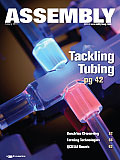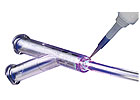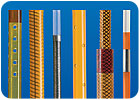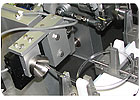
It’s hard to find a medical device that doesn’t use some sort of plastic tubing. Everything from intravenous (IV) catheters and hemodialysis equipment to feeding pumps and implantable devices relies on a wide variety of tubes to carry oxygen, blood, medicine and other liquids or gases. In addition, tubing is used to sheathe thin wires that control surgical instruments.
However, tiny tubing often presents a big challenge to engineers, especially when automated assembly equipment is involved. Medical tubing must be flexible, thin-walled and kink-resistant. Other important factors include biocompatibility, clarity, sterilization resistance and low cost.
Today, there’s a “great need to investigate alternative extrudable materials that can be converted into tubing,” says Joe Kutka, technology launch manager for GLS thermoplastic elastomers at PolyOne Corp., a leading supplier of specialized polymers. “[They] are being screened as potential replacements for traditional materials due to concerns about extractables, a trend toward higher autoclaving temperatures, and anticipated regulatory changes.”
As a result, medical engineers keep pushing the limits. They’re asking questions such as, “how thin and small can plastic tubing be extruded and still keep exceptionally tight tolerances?” “How much bend can be given before the tube kinks?” “How can any deficiencies be re-engineered?”
“Engineers of medical devices seek what, in many cases, can’t be made,” claims Timothy Lynch, operations manager at MicroLumen Inc., a leading manufacturer of polyimide tubing. “For example, they want a very thin wall thickness that has tremendous column strength and torque strength, but is extremely flexible and kink-resistant.
“It’s all about trade-offs,” adds Lynch. “Engineers have to carefully decide what characteristics are the most important and which are the least important, because each tube design is limited in some way by the materials and their combination of characteristics.”

Increasing Demand
Nontraditional methods of surgery are the rule rather than the exception today. Minimally invasive procedures are less expensive, consume less time and involve fewer risks. And, they use minimal surgical openings that involve less pain for the patient and help speed recovery.According to BCC Research, the global market for minimally invasive medical devices is growing 8 percent annually. As less invasive surgery becomes more popular, medical tubing is undergoing rapid change.
“The growing popularity of minimally invasive surgery among medical [professionals] has been mainly due to the development of specialized, smaller tubes,” says Aniruddh Menon, a research associate at Frost & Sullivan Inc. “There is a huge demand for plastic tubing today compared to 10 years ago. These tubes have thinner walls to make the space inside sufficient enough to accommodate medical instruments, including guide wires.”
Medical tubing has become smaller in diameter and thinner than before due to advances in polymer materials. “There has clearly been a trend toward smaller diameters and thinner walls for minimally invasive devices,” notes Mark Saab, president of Advanced Polymers Inc., a manufacturer of polyester heat shrink tubing. For instance, diameters now typically range from 0.005 to 0.45 inch. Tolerances can be as low as ±0.00025 inch.
“For procedures such as angioplasty, smaller diameter, thinner wall tubing is desirable because of better maneuvering through arteries and veins,” says Bill Martineau, healthcare industry analyst at the Freedonia Group. “For applications such as IV administration and urinary drainage, size and structure are less important than barrier properties.”
Medical device manufacturers typically demand tubing that provides for easy placement and maneuverability, while reducing the risk of complications such as infection or drug contamination. But, tubing has become much more complex.
“The industry continues to push the limits of the materials,” says Don Centell, vice president of operations at ExtruMed, a company that specializes in catheter tubing. “Tri-layer, balloon, implantable and taper tubing are now the norm. More customers are looking for specialized, braided tubing that is smaller, more intricate and requires considerable engineering resources to support it.” Wire braiding is used to make tubes more kink-resistant and improve burst strength.
Medical engineers are also turning their attention to co-extruded tubing and heat-shrink sheathing, especially when it comes to polytetrafluoroethylene resins. Co-extruded tubing is becoming popular because it improves lubricity. “Methods like heat-shrink sheathing also help in the development of smaller and thinner tubes,” says Menon.
As surgical instruments get smaller and smaller, tubing plays a larger role. “A lot of new instruments rely on tubing as the structural element to get the working tip to the tissue or organ,” says Len Czuba, president of Czuba Enterprises Inc., a medical device design firm. “In addition to surgical instruments, tubing is used for suction, fluid delivery and lighting.”

New Materials
Medical tubing can be made out of several types of plastic, including polyvinyl chloride (PVC), polyethylene, thermoplastic elastomers (TPE), nylon and silicone. However, PVC is the most popular, accounting for approximately 30 percent of the market. It withstands high temperatures used in sterilization, and it bonds easily with other types of plastics. Non-PVC tubing is often more difficult to bond, because chemicals don’t react as quickly or as efficiently.Cost also plays an important role in the widespread use of PVC. “Out of all materials used for tubing applications, PVC is the cheapest,” says Menon. “Patients want to get quality medical treatment at an affordable price. PVC makes that happen.”
For commodity products, such as IV tubing and blood tubing, PVC is the material of choice. “However, it does not provide all the technical features like heat-shrinkability or tight tolerance that a fluropolymer can provide,” notes Menon.
“Polyethylene (PE) comes closest to PVC in terms of cost, but it does not match the physical properties of PVC,” Menon points out. “Although PE is the second most used plastic for medical tubing applications, in terms of volume, it has some drawbacks compared to PVC.”
For instance, PE is not as flexible as PVC, nor does it bond as well with other plastics. Polyethylene is not as clear as PVC, so it is less useful when visual monitoring of fluids inside tubes is essential.
“Polyethylene tubing is 30 percent lighter than PVC, and is highly chemical resistant and cost competitive,” adds Martineau. “The material’s slow coefficient of friction makes it particularly suitable in tubular guide wire dispensers for angioplasty procedures. However, polyethylene does not solvent bond to plastics like PVC.”
In addition to PE, a wide variety of PVC alternatives are being considered today. “[Polyvinyl chloride] is slowly but surely losing its popularity, as more governing bodies are putting pressure on medical companies to change due to multiple studies that have concluded that PVC may have some harmful affects to the human body,” says Centell.
Traditionally, manufacturers use plasticizers to produce a flexible material that is conducive to the formation of tubes. However, those additives have become a topic of debate in the medical device industry, due to the potential for these chemicals to leach out of the material and become an exposure risk to patients.
“Medical device manufacturers are not too satisfied with using PVC because of the di ethyl hexyl phthalate plasticizer issue,” explains Menon. “Over the next 10 years, we could see more PE and TPE replacing PVC. While TPE provides almost the same features as PVC, it is more expensive.”
A variety of materials that fall under the TPE umbrella can be used for tubing applications. “Certain TPEs will provide high clarity, whereas others can be translucent,” says Kutka. “TPEs can also be extruded at faster rates than PVC. [Attachment] of valves and connectors has to be evaluated by the manufacturer. Whereas enhanced line speeds can be achieved, solvent-bonding to connectors may not be as fast as that seen with PVC.”
Advanced material science technology now allows manufacturers to create a wide variety of hybrid tube products. Compared to conventional thermoplastic items, composite tubing offers a high strength-to-weight ratio, rigidity, and the ability to maintain precise tolerances. These state-of-the-art tubes have different layers of material in them, which help in gaining the desired properties based on a particular application.
“End users are keen on getting the desired technical requirements in a material of their choice,” explains Menon. “Custom blending is the solution to get the ideal material that can satisfy their material requirements. It literally enables them to get desired properties of two or more plastic materials in a single material.”
“Customers are looking for any competitive advantage,” adds Centell. “By enhancing material properties and performance, they can [tout] what their product can do [vs. what] others cannot, such as easier tracking through the anatomy, easier [detection on] X-rays, higher rupture pressure, lower profiles and other enhanced performance characteristics.”

Assembly Challenges
Manual and semiautomated assembly processes are traditionally used to attach tubes to valves, connectors and other devices. Unfortunately, plastic medical tubing can be difficult to work with, due to flexibility and tight tolerances.
“Some tubes are much easier [to assemble] than others,” says Howie Speiden, applications engineering manager at Sortimat Technology. “[But], tubing has a few common characteristics. [For instance], it’s flexible, so you cannot rely on its mechanical integrity for straightness and stretches in some cases.
“Material memory is [another] important variable,” Speiden points out. “Also, tubes [often] vary from the start of a reel to the end of a reel. At the end of a reel, the wind radius is much tighter, making it difficult to straighten some tube material. In addition, the tube can become collapsed. Automation must be able to account for [all these variables. That’s why] the vast majority of lower volume assemblies are [produced] with manual labor and benchtop tooling.”
“In many cases, the return on investment for automated solutions remains difficult to justify,” says Rush LaSelle, director of worldwide sales and marketing at Adept Technology Inc. “The removal from packaging and untangling of thin or long tubes tends to be complicated and expensive. Manual [assembly] provides a level of dexterity in separating tubes, and in some cases, the ability to assemble tubes in tight assembly configurations that, for now, exceed automated solutions.”
According to LaSalle, medical device manufacturers will use more robots to assemble tube sets in the future. He says the two biggest challenges that need to be addressed are “the propensity for longer tubes to entangle and the ability to locate and reliably pick the tubes given their often exceedingly pliable nature.”
When tubes are opaque and visually distinguishable, robots equipped with vision technology can handle some of these applications. “Assemblies with complex structures can pose challenges, but no more for the assembly of tubes than any other component,” claims LaSalle. “Increasingly, robots are being placed into these applications as smaller grippers are developed and alternate sensory feedback solutions, such as force feedback, are more widely adopted.”
Although ultrasonic welding is widely used in the medical device industry to assemble many different types of products, the soft nature of tubing makes it difficult to join with the technology, which typically works better on rigid plastics. To address that issue, manufacturers have traditionally used solvent welding. But, that’s starting to change.
“We have seen a steady increase in requests for alternatives to the traditional tube assembly methods,” claims Christine Salerni Marotta, medical focus segment manager at Henkel Corp. “Solvents have long been the topic of review, due to their potential health risks. In addition, solvent welding can be [used on a limited number of substrates].
“There are many common tubing materials where solvents do not provide adequate bonding or welding due to material compatibility,” explains Marotta. “In addition, solvent and other welding processes require that the substrates being joined be either the same or very similar in chemical makeup. Tight alignment is also a typical requirement for welding, which can translate to higher machining and molding costs to ensure that gaps are kept to a minimum.”
“Demand for adhesives in plastic medical tubing is increasing,” adds Kyle Rhodes, medical market segment manager at Dymax Corp. “Adhesives offer the ability to fill gaps. Therefore, gap tolerances can be looser, which is less costly. Adhesives can bond many different substrates, so multisubstrate applications, such as attaching polyether block amide to stainless steel or polycarbonate to nitinol, [can be] done at one time, rather than separate design applications.
“Adhesives are able to create strong bonds between the various substrates, but can absorb some of the shock and stress that a component might be subject to,” Rhodes points out. “Many of today’s adhesives also fluoresce under a black light, giving [assemblers] the ability to look for voids and lead paths.”
Learn more about plastic medical tubing by clicking www.assemblymag.com and searching for these articles:
- Adhesives and Tubing.
- Automated Tube Assembly Is Easier Said Than Done.
- Plastic Tubing Bonding Tips.
